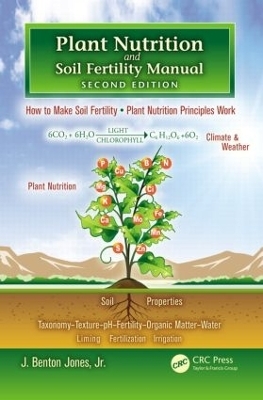
Plant Nutrition and Soil Fertility Manual
Crc Press Inc (Verlag)
978-1-4398-1609-7 (ISBN)
As soil and crop management procedures have become more complex, County Agricultural Agents, farm advisors, consultants, and fertilizer and chemical dealers have had to specialize in some aspect of soil fertility and crop nutrition management procedures, limiting their ability to provide a range of advice and services. Most farmers and growers can no longer turn to just one source for the information and instruction needed to achieve their production goals.
With over 70 percent new material, the second edition of the Plant Nutrition and Soil Fertility Manual discusses the principles determining how plants grow and the elements essential for successful crop production, with a focus on the principles of soil fertility and plant nutrition. The book covers physical and chemical properties of soil, chemical and organic fertilizers, soil acidity and alkalinity, liming and liming materials, and micronutrients essential to plant growth. It also describes elements toxic to plants, soil testing, and plant analysis.
The topics and discussion in this self-contained book are practical and user-friendly, yet comprehensive enough to cover material presented in upper-level soil and plant science courses. It allows practitioners with general background knowledge to feel confident applying the principles presented to soil/crop production systems.
Dr. J. Benton Jones has written extensively on the topics of soil fertility and plant nutrition over his professional career. After obtaining a B.S. degree in Agricultural Science from the University of Illinois, he served on active duty in the U.S. Navy for two years. After discharge from active duty, he entered graduate school, obtaining M.S. and Ph.D. degrees from the Pennsylvania State University in agronomy. For 10 years, Dr. Jones held the position as research professor at the Ohio Agricultural Research and Development Center (OARDC) in Wooster. During this time, his research activities focused on the relationship between soil fertility and plant nutrition. In 1967, he established the Ohio Plant Analysis Laboratory. Joining the University of Georgia faculty in 1968, Dr. Jones designed and had built the Soil and Plant Analysis Service Laboratory building for the Georgia Cooperative Extension Service, serving as its Director for 4 years. During the period from 1972 and his retirement in 1989, Dr. Jones held various research and administrative positions at the University of Georgia. Following retirement, he and a colleague established Micro-Macro Laboratory in Athens, Georgia, a laboratory providing analytical services for the assay of soils and plant tissues as well as water, fertilizers, and other similar agricultural substances. Dr. Jones was the first President of the Soil and Plant Analysis Council and then served as its Secretary-Treasurer for a number of years. He established two international scientific journals, Communications in Soil Science and Plant Analysis and the Journal of Plant Nutrition, serving as their Executive Editors during the early years of publication. Dr. Jones is considered an authority on applied plant physiology and the use of analytical methods for assessing the nutrient element status of rooting media and plants as a means for ensuring plant nutrient element sufficiency in both soil and soilless crop production settings.
Introduction. Soil Fertility Principles. Plant Nutrition Principles. The Plant Root. How to be a Diagnostician. Physical and Physiochemical Characteristics of Soil: Soil Taxonomy, Horizontal Characteristics, and Clay Minerals. Physical Properties of Soils. Physiochemical Properties of Soil. Soil pH: Its Determination and Interpretation. Soil Organic Matter. Plant Elemental Requirements and Associated Elements: Major Essential Plant Elements. Micronutrients Considered Essential to Plants. Elements Considered Beneficial to Plants. Elements Considered Toxic to Plants. Trace Elements Found in Plants. Methods of Soil Fertility and Plant Nutrition Assessment: Soil Testing. Plant Analysis and Tissue Testing. Amendments for Soil Fertility Maintenance: Lime and Liming Materials. Inorganic Chemical Fertilizers and Their Properties. Organic Fertilizers and Their Properties. Fertilizer Placement. Soil Water, Irrigation, and Water Quality. Methods of Soilless Plant Production: Hydroponics. Soilless Rooting and/or Growing Media. Miscellaneous: Organic Farming/Gardening. Weather and Climatic Conditions. Best Management Practices (BMPs). Appendices: Glossary. Formulation and Use of Soil Extraction Reagents. Preparation Procedures and Elemental Content Determination for Plant Tissue. Weights and Measures. Reference Books and Texts. References. Index.
| Erscheint lt. Verlag | 16.3.2012 |
|---|---|
| Zusatzinfo | 10 Tables, black and white; 10 Illustrations, black and white |
| Verlagsort | Bosa Roca |
| Sprache | englisch |
| Maße | 156 x 234 mm |
| Gewicht | 430 g |
| Themenwelt | Naturwissenschaften ► Biologie ► Biochemie |
| Naturwissenschaften ► Biologie ► Botanik | |
| Weitere Fachgebiete ► Land- / Forstwirtschaft / Fischerei | |
| ISBN-10 | 1-4398-1609-3 / 1439816093 |
| ISBN-13 | 978-1-4398-1609-7 / 9781439816097 |
| Zustand | Neuware |
| Haben Sie eine Frage zum Produkt? |
aus dem Bereich


